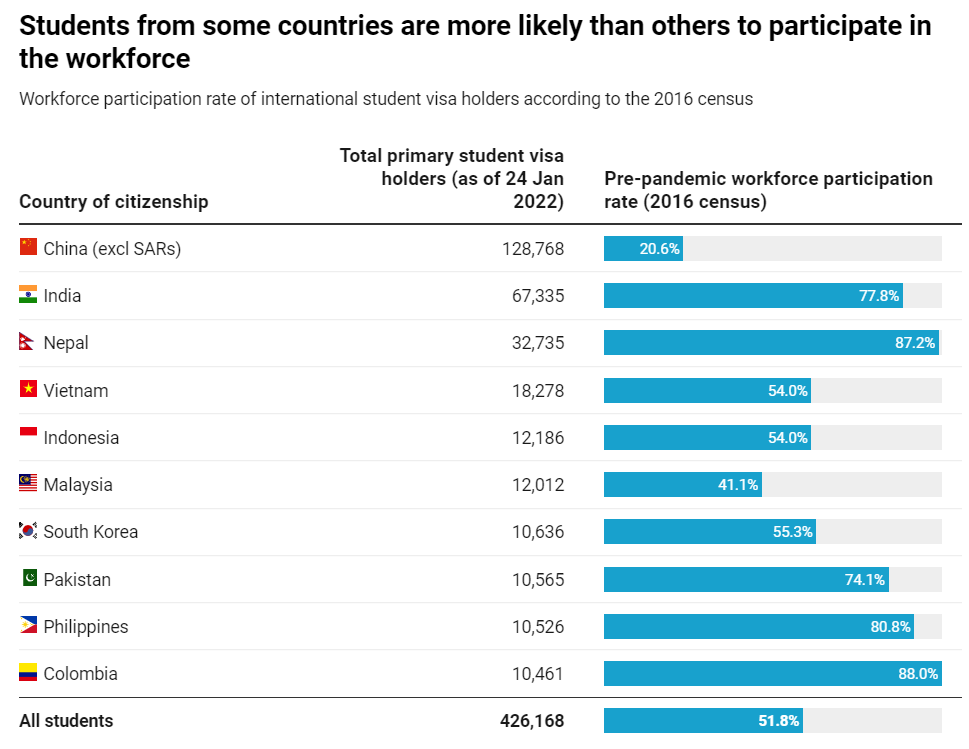Late last year, Canada’s Globe & Mail reported on how hundreds of thousands of Indian students have flooded into Canada in search of permanent residency [my emphasis]:
Grey Matters, which sees 7,000 to 8,000 students each month at its 56 locations in India, is one of many such centres in Chandigarh’s sprawling Sector-17 market, a hub of retail stores and education institutes that has become known as a one-stop shop for young Indians itching to begin their adult lives abroad.
Businesses like this all over the country send tens of thousands of Indian students like Manjinder to Canada each year – 105,192 were enrolled in Canadian universities and colleges in the 2018-2019 school year, the most recent period for which data are available. They promise a new life, jobs, houses and prosperity and – ever since the federal government introduced a series of programs in 2009 that opened the gates more widely to Indian students – a chance at the ultimate prize: Canadian citizenship…
Bringing Indian students to Canada has become a lucrative business spanning two continents. In India, there are language schools, recruiters, immigration consultants and lenders, all of whom have profited handsomely from the study-abroad craze. Once students arrive in Canada, postsecondary institutions, landlords, immigration consultants and employers profit from their growing presence…
The vast majority of Indian students… are registered at colleges (73 per cent). Students and recruitment businesses interviewed by The Globe say this is because most Indian students want to come to Canada to live rather than learn…
Gurpreet Malhotra, the executive director of Indus Community Services, says he’s come to see private colleges in Canada as being in the business of immigration, not education. “The colleges are getting easy money, and the students are getting an easy way to get to Canada”…
Yesterday, The Guardian posted a similar article explaining how more Indian students would be enticed to study in the United Kingdom if it extended post-study work visas to three years:
International students would be more likely to consider studying in the UK if they were allowed to stay and work for three years instead of two, a survey suggests…
An extension would be especially appealing to Indian students, with nearly three-quarters (73%) saying three years would make them a lot more likely to consider the UK. Numbers of Indian students choosing to study in the UK fell dramatically after the abolition of the two-year post-study work visa in 2012, and have quadrupled since it was reinstated.
These reports are no surprise. As shown in the below graphic, the overwhelming majority of students from the Indian subcontinent undertook paid employment in Australia to support themselves, which by extension means that Indian students are not a genuine export but rather a people import:

Just like Canada and the United Kingdom, a recent study by IDP Connect revealed how the prime motivation for Indian students to study in Australia is to gain permanent residency and work rights:
IDP Connect’s New Horizons research shows international students consider migration incentives and employment opportunities when choosing where, what and how to study. “We’ve seen a significant decrease in interest from Indian students looking to study in Australia,” said Wharton, who said a key motivation for Indian students’ decision to study abroad include migration and face-to-face learning opportunities…
Wharton said if Australia can communicate a roadmap towards a large-scale return of international students, with clear pathways towards employment and migration outcomes, Australia could be in a good position to retain its status as a leading study abroad destination…
The former vice-chancellor of Macquarie University, Professor Steven Schwartz, similarly admitted that many international students only study in Australia to gain working rights and permanent residency:
[Professor Schwartz] said foreign students flock to courses likely to lead to jobs and permanent residency…
“Permanent residency is one of the main motivations to study in Australia’…
“If suddenly permanent residency was given to people who study poetry, it’s likely they’d all be doing poetry.”
New Delhi-based education consultant Gauravdeep Bumra noted the similar:
“Most Indian students choose to study abroad, often at the cost of thousands of dollars, because they have a long-term goal of getting permanent residency, be it in Australia, Canada or the UK”.
“The day they open their borders, the student intake numbers will uptick…”
As has The Australian’s international education correspondent, Tim Dodd:
“Too many of the expanding numbers of students from India and the sub continent were in low quality, generic business courses, and hoping for permanent residency without having in-demand skills”.
Any move to lift international student numbers and immigration will necessarily require Australia to reach further down the quality barrel and erode entry standards even further. Doing so would be detrimental for the long-run productivity and prosperity of Australia, which relies upon quality education and skills.
Instead of lowering the quality bar even further to boost numbers, Australia’s international education system should instead target a smaller intake of high quality students via:
- Lifting entry standards (particularly English-language proficiency);
- Lifting financial requirements needed to enter Australia; and
- Removing the link between studying, work rights and permanent residency.
These reforms would raise student quality, would lift genuine export revenues per student, would lift wage growth by removing competition in the jobs market, and would lower enrolment numbers to sensible and sustainable levels, in turn improving the experience for local students.
Put simply, Australia’s higher education sector must be focused on ‘higher learning’ rather than ‘higher earning’. International education needs to become a genuine export industry rather than a people importing immigration industry.
Sadly, we all know these reforms would never happen. If work rights and permanent residency were scaled back, the numbers of students arriving would collapse.
Our policy makers will instead crater standards even further to entice as many warm bodies into Australia as possible. Because the edu-migration industry rent-seekers demand it.

